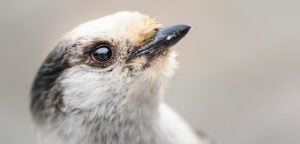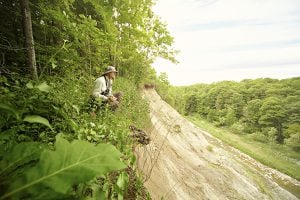
Science & Tech
20 Canadian innovations you should know about
Celebrating Canadian Innovation Week 2023 by spotlighting the people and organizations designing a better future
- 3327 words
- 14 minutes
Travel
If you’ve got a dinosaur-obsessed child — or a keen interest in paleontology yourself — add these fascinating museums and experiences to your travel bucket list

Dan Aykroyd offers me another generous pour of vodka, and who am I to refuse? We’re sitting outside a corral of trailers in the bush outside of Grande Prairie, Alberta., and the conversation has turned to dinosaurs. Beyond his comedic talent, Aykroyd is a huge dinosaur nut and a key fundraiser for the Philip J. Currie Dinosaur Museum. The award-winning, $34 million facility, which opened its doors in 2015, sits adjacent to Pipestone Creek, one of the densest fossil beds anywhere in the world. It is final resting place for thousands of hadrosaur, tyrannosaur, nodosaur, plesiosaur, and pterosaur fossils. Although, as my five-year-old son Galileo reminds me, plesiosaurs and pterosaurs are not actually dinosaurs; they are marine reptiles that swum and flew during the time of the dinosaurs. “Gee, Dad, don’t you know anything?”
I do know that Canada is a global dinosaur hotspot. Sixty-five million years ago, the landscape was full of rivers, swamps, marshes and seaways. Sweltering humidity ensured lush plant life, which attracted large herbivores and the meat-eaters that preyed on them. Rivers and streams washed over animal carcasses in the floodplains, burying bones in sediment and creating ideal conditions for fossilization. Millions of years later, glacial erosion scoured away the top layers of soil, exposing new fossil beds to the delight of palaeontologists, amateur and otherwise. Scientists, farmers, students, miners, hikers and even kids have stumbled across remarkable dinosaur finds, most famously in and around the arid landscape of Drumheller, Alta., but further afield too.
In 1991, a high school teacher discovered a giant T. rex skeleton while canvassing the badlands near Eastend, Saskatchewan. Nicknamed Scotty, this 13-metre-long, 8,800-kilogram beast is the largest T. rex ever discovered. It took years to safely remove it from its sandstone tomb, but today you can meet Scotty face-to-face at the Royal Saskatchewan Museum’s T. rex Discovery Centre in Eastend. Not to be outdone, the Canadian Fossil Discovery Centre in Morden, Manitoba will proudly introduce you to Bruce, who holds the Guinness World Record as the largest publicly displayed mosasaur. Bruce sounds affable enough, except this 13-metre-long, 80-million-year-old marine reptile swum at the very top of its food chain, devouring anything in its path as it prowled the inland seas that covered what is now the Canadian prairies.
Eighty million years is a flash in the pan as you head further east. Canada’s oldest discovered dinosaurs are long-necked Triassic-era plateosaurs, which were found in the Bay of Fundy. Their 200-million-year-old fossils await you in Nova Scotia’s Fundy Geological Museum, which also offers hands-on fossil walking tours into the bay, and even an overnight fossil tour on horseback. Dinosaur buffs in Toronto know all about the Age of Dinosaurs Gallery inside the Royal Ontario Museum, which features many complete mounted dinos, including Gordo, the largest real fossil skeleton in the country, and one of only three barosaurus on display in the world. There’s also six complete original fossil hadrosaurs, a stegosaurus, and an exhibit about the intriguing Bone Wars between two overly competitive American paleontologists. Dino bones are big business, with a full skeleton worth millions of dollars.

At this point, Galileo wants you know that allosaurus had three fingers, T. rex only two, and that his favourite dinosaur is the spinosaurus of North Africa, the largest carnivore that ever lived. Canada lost out on that one.
Drumheller’s Royal Tyrrell Museum is still the Grand Central Station of the dinosaur world. Some 800 fossils are on permanent display, organized by era, representing just a fraction of the 160,000 fossils the museum has in its permanent collection. Alberta’s bone-bed bounty ensures that thousands of new fossils are added every year. The museum’s Dinosaur Hall boasts one of the largest mounted displays of dinosaurs anywhere in the world, including fan-favourites triceratops and its mortal enemy, T. rex. You can also meet home-grown dinos like the gorgosaurus — a close cousin of T. rex who I’d like to think was more polite — and the herd-roaming Edmontosaurus. The museum offers dozens of programs designed to introduce visitors of all ages to the wonders, ideas, history and hard-earned joy of paleontology.
I promised Galileo we’d put his dinosaur books away and see the real thing, but Dinosaur Provincial Park is a 15-hour drive from home. While I don’t doubt his commitment, I also don’t doubt his uncanny ability to get carsick in seconds. Instead, we hopped on the ferry from Vancouver to visit the Courtenay Dinosaur Museum on Vancouver Island. In 1988, local fossil enthusiast Mike Trask was exploring a local river when he discovered an 80-million-year-old elasmosaurus, the first of its kind in Canada. Today, Mike leads excited kids (and their grateful parents) into the town’s surrounding creeks, supplying the chisels, hammers, know-how, storytelling, and encouragement to crack shale in search of prehistoric wonders. Smashing rocks! For dinosaurs! It was the biggest smile I saw on my kid all summer, and while Galileo didn’t unearth any major discoveries, he’s still proud of his tiny ammonites.
Contrary to popular belief, not all dinosaurs went extinct. Some merely adapted to their new environment, evolving into creatures we call “birds.” As we continue to explore eons of Earth’s geological history, consider that the science of paleontology is just several centuries old. There’s so much to learn and discover. Any visit to Canada’s fantastic, hands-on dinosaur museums will inspire the next generation to do exactly that.
Are you passionate about Canadian geography?
You can support Canadian Geographic in 3 ways:

Science & Tech
Celebrating Canadian Innovation Week 2023 by spotlighting the people and organizations designing a better future

Travel
The trail started with a vision to link Canada coast to coast to coast. Now fully connected, it’s charting an ambitious course for the future.

Wildlife
Canada jays thrive in the cold. The life’s work of one biologist gives us clues as to how they’ll fare in a hotter world.

Places
It’s an ambitious plan: take the traditional Parks Canada wilderness concept and plunk it in the country’s largest city. But can Toronto’s Rouge National Urban Park help balance city life with wildlife?